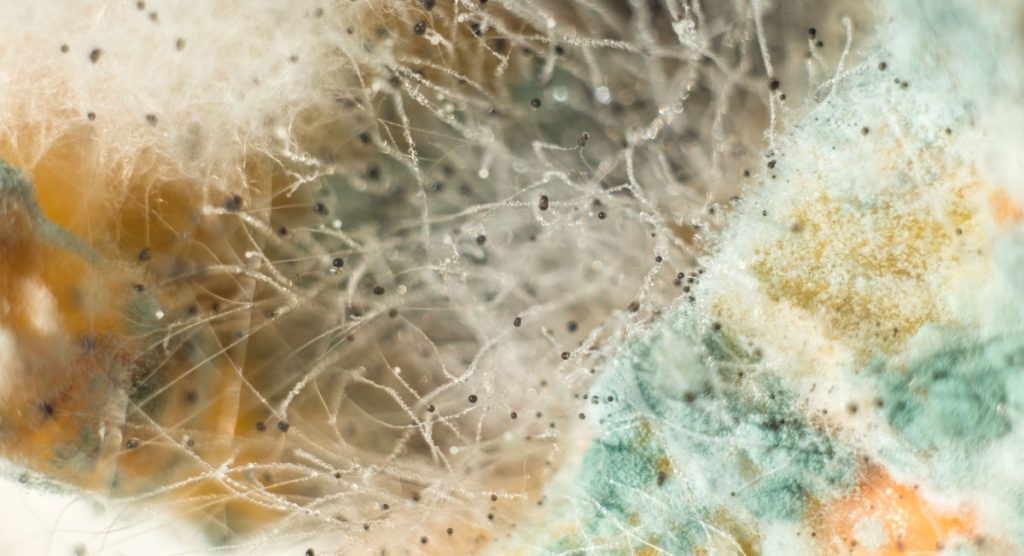Mushroom contamination is one of the biggest challenges most mushroom cultivators encounter.
Regardless of whether you’re a beginner or an experienced mushroom grower, you cannot rush the mushroom growing process and skip vital steps that help prevent contamination.
But what is mushroom contamination, and why is it such a big deal?
Read on to learn what mushroom contamination is, types of contamination and common causes with tips to help you prevent mushroom contamination.
What is Mushroom Contamination?
Contamination is the phrase used for unwanted organisms or microorganisms that interfere with mushroom growth and cause long-term problems or crop failure.
Contaminants may be in your substrate or on your mycelium or mushrooms and often spread quickly in growing room conditions.
Can Mushroom Spores be Contaminated?
Mushroom spores have an extremely tough, solid cell wall with a unique structure. This cell wall protects the spores from extreme environmental conditions and contamination.
But when you make a spore print to collect spores for a spore syringe, it’s impossible to separate the microscopic spores from any bacteria that may be collected with the spores.
The temperatures required to kill the bacteria would also kill the spores. This means most spore syringes have some bacterial contaminants and are best used to inoculate sterilized grain, not agar plates.
Bacteria grow well on agar, and mushroom mycelium often struggles to effectively compete, but when introduced directly to grain, mycelium usually outperforms any bacterial contaminants.
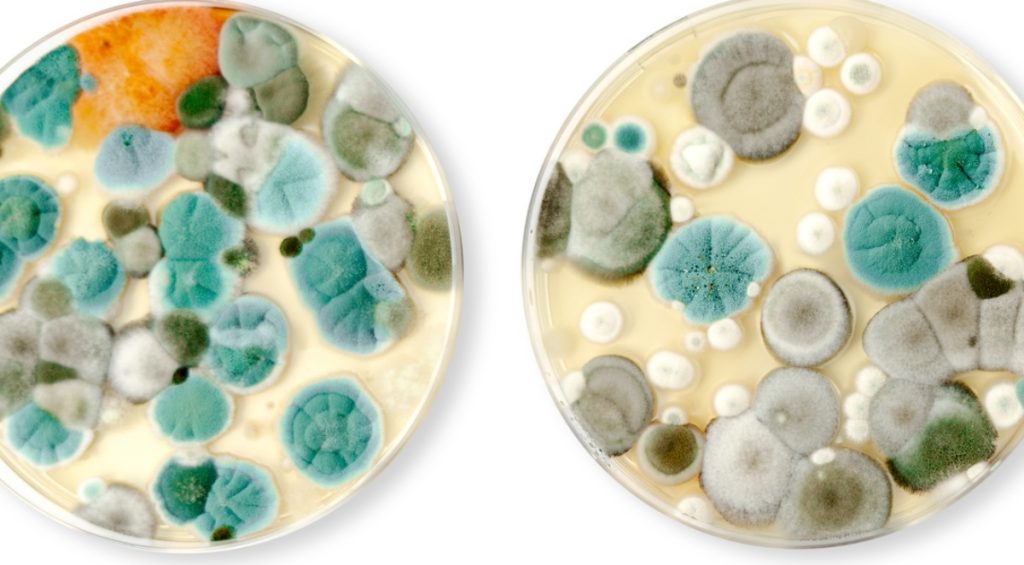
Types of Mushroom Contamination
There are several different types of mushroom contamination caused by various organisms, including:
Bacterial Contamination
Bacteria are microscopic, single-celled organisms found everywhere, even inside our bodies.
Like mushrooms, bacteria enjoy damp conditions and thrive in the growing conditions we create for mushrooms.
Bacterial contamination is usually the result of contaminated water, substrate or equipment and can be avoided by using sterilized substrates and clean, sterile work surfaces and tools.
Fungal Contamination
Mushroom-producing fungi are not the only fungi that enjoy the damp, nutrient-dense conditions inside a mushroom substrate.
Mold also thrives in these conditions, and like mushrooms, molds have microscopic airborne spores that float about in the environment around us.
Fungal contaminants can be inside substrates or on your equipment, and airborne fungal spores often contaminate substrates during inoculation.
Inoculating your substrate in a still air or glove box or in front of a laminar flow hood can help prevent any airborne contaminants from getting into your substrate.
Pest or Parasitic Contamination
Insects and other parasitic organisms that feed on mushroom mycelium and fruiting bodies are problematic for many mushroom growers.
Many tiny, almost microscopic pests thrive in the straw and compost substrates used for mushroom growing and feed on the mycelium, causing damage and abnormal growth.
Other, more visible, insects feed on the mushrooms themselves.
Maintaining proper sanitation, using quality spawn and substrate materials, and implementing pest management strategies helps prevent this type of contamination.
Viral Contamination
Like humans, fungi can also be infected by viruses, causing abnormal mushroom growth and reduced yields.
The viruses that infect fungi are called mycoviruses and they use fungal hyphae and mycelium to survive and spread.
To help prevent viral contamination, always buy high-quality, virus-free mushroom spawn from a reputable supplier.
Good hygiene and keeping your workspace, tools and equipment clean will also reduce the chances of introducing viruses.

11 Common Mushroom Contaminants
Below is a list of some of the most common mushroom contaminants encountered by cultivators.
Fungal Contaminants
Molds are fungal contaminants and probably the most common mushroom contaminants of all. They’re extremely dangerous in a mushroom-growing space as they reproduce and spread quickly.
Numerous fungal contaminants could impact your mushroom-growing endeavors, but we’re going to focus on six of the most common, including:
1. Aspergillus spp.
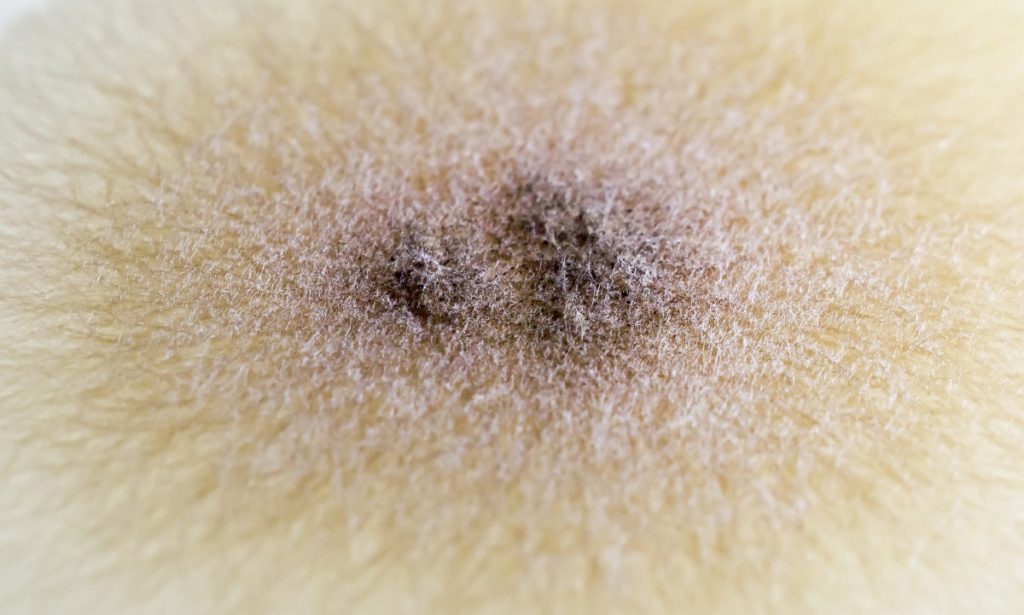
Aspergillus is a family of mold commonly found in indoor air, dust, soil, and wood that smells musty or like wet dirt.
It produces microscopic spores that can travel significant distances and is a common contaminant of mushroom substrates.
Aspergillus mycelium is usually light gray with linear threadlike growth similar to mushroom mycelium, making it difficult to spot before it produces spore-bearing structures or sporophores.
There are several types of Aspergillus mold, and their sporophores vary in shape and color, with gray, yellow, green, blue and black being the most common.
Because they’re so varied in appearance, it can be challenging to differentiate Aspergillus from other mold species that contaminate mushroom substrates.
2. Trichoderma spp.

Trichoderma is one of the easiest contaminants to recognize and has the reputation of being the most common contaminant in mushroom cultivation and also one of the most difficult to contain.
This genus of green molds is found in soil, and their spores adhere to dust particles that carry them indoors.
Trichoderma can appear at any stage of the cultivation process and is exceptionally fast-growing, quickly colonizing a substrate and outcompeting the mushroom mycelium.
These molds are not only fast-growing. They also produce enzymes that degrade the cell walls of mushroom mycelium, inhibiting growth or killing the mycelium.
The first sign of trichoderma contamination is a fast-growing layer of bright-white, fluffy mycelium that looks like it’s rising above the surface of the substrate.
This mycelium can sometimes be challenging to distinguish from the mushroom mycelium, but once the Trichoderma produces its bright blue-green spores, it’s easy to identify.
If you see Trichoderma on your substrate, remove the contaminated substrate immediately and clean the surrounding area and any tools before it gets a chance to spread.
3. Penicillium spp.
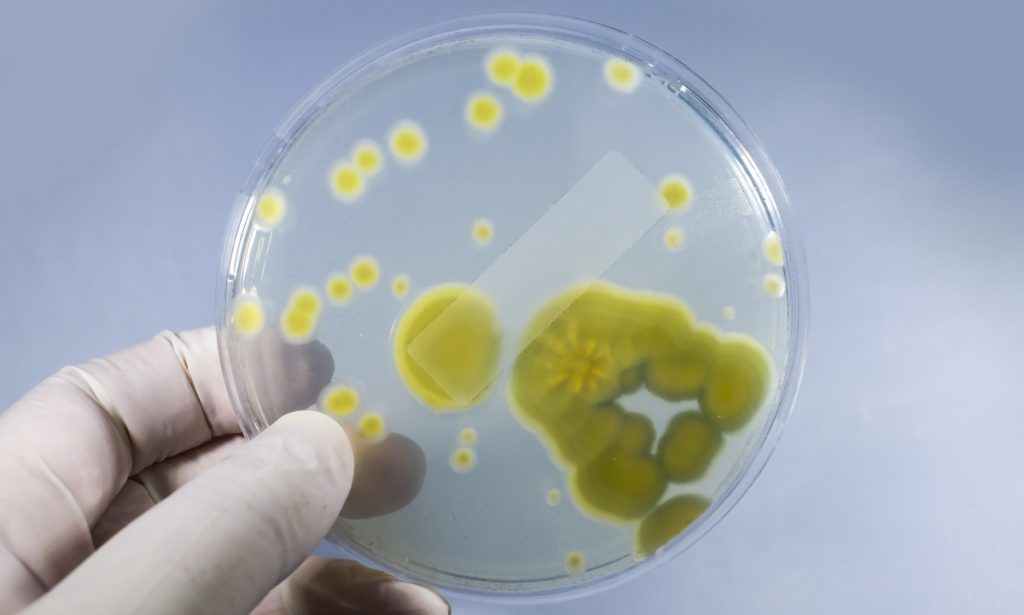
Penicillium is another common mold found indoors, and like Aspergillus, it has tiny spores that remain airborne for extended periods.
Penicillium is usually found in agar plates and grain spawn jars and is seldom seen on mushrooms after spawning.
If Penicillium appears after pinning, it usually does not significantly affect yields.
Penicillium mycelium is white and usually grows in circles, producing green or yellow spores shortly after appearing.
4. Orange Bread Mold (Neurospora Crassa)
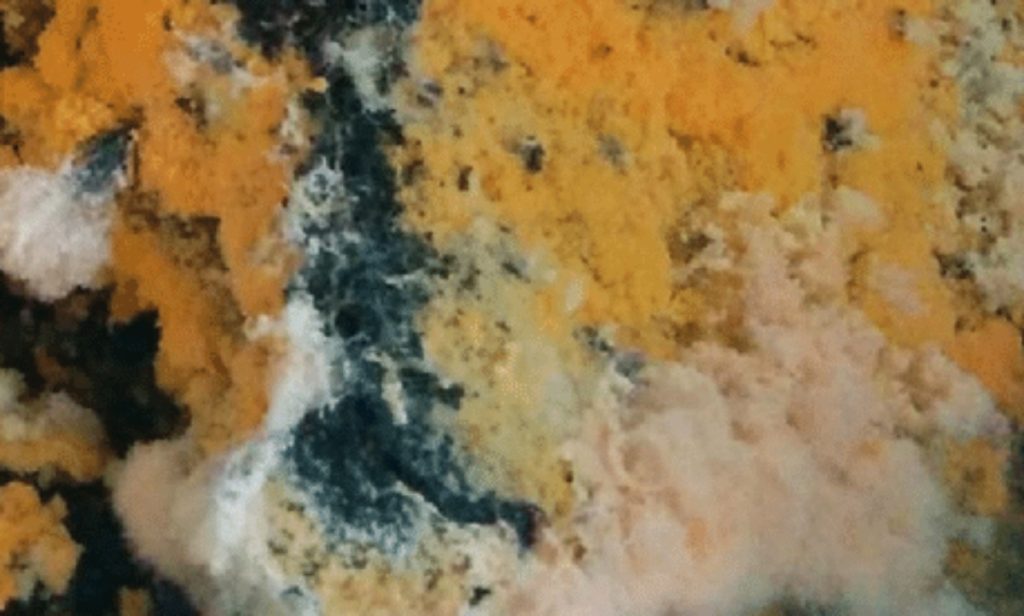
Orange bread mold is exceptionally fast-growing and very common in tropical and subtropical regions as it enjoys warm, humid conditions.
It thrives in damp wood, compost and coffee grinds, and people sometimes find it growing in coffee machines.
Although harmless to humans, this bright orange mold easily outcompetes mushroom mycelium.
At first, it looks like thin orange-white wisps that quickly become bright orange powdery patches. If you miss them at this stage, they continue growing, produce round orange lumpy formations and release their spores.
Orange bread mold can appear, grow and sporulate in 8 to 12 hours, and if left to grow, it could spread to other fruiting blocks, destroying an entire crop.
If you come across orange bread mold, seal the contaminated substrate in a plastic bag and dispose of it immediately.
If the mold has reached the lumpy stage, try not to disturb it, as it will release a cloud of fine orange spores and spread.
5. Cobweb Mold (Hypomyces Rosellus)
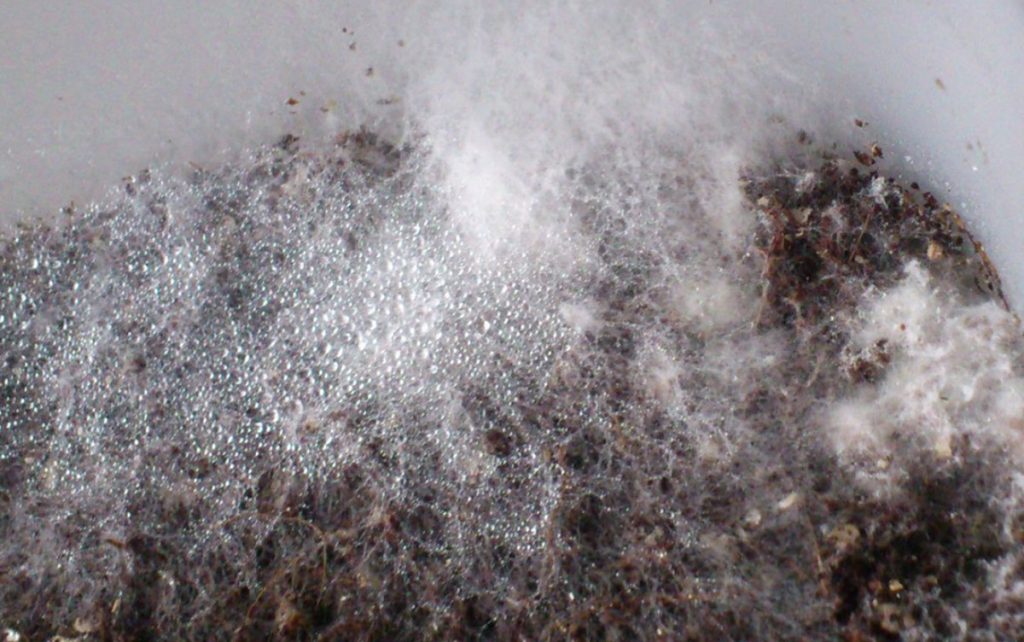
Cobweb mold enjoys environments with little airflow and high humidity and usually infects grain jars and monotub fruiting chambers.
Although this mold is light gray and not white, beginners sometimes find it hard to distinguish cobweb mold from mushroom mycelium, but a closer inspection will help.
Cobweb mold grows in wispy tufts above the substrate and has a noticeable, damp, musty smell.
It often forms towards the end of incubation, when the substrate is fully colonized and ready for fruiting, and can cover an entire jar or monotub in 24 to 48 hours.
Cobweb molds are parasitic on other fungi. If left untreated, they can cause mushroom pins to abort or mature mushrooms to rot.
If you spot cobweb mold in its early stages, you can eliminate it by spraying a 3% hydrogen peroxide solution onto the infected area. This will not harm your mushroom mycelium but will kill any cobweb mold in your jar or monotub.
6. Black Bread Mold (Rhizopus Stolonifer)

Black bread or pinhead mold has the same wispy appearance as cobweb mold but develops tiny black pinheads on the ends of its mycelium that produce spores.
This mold is fast-growing and often the first to appear on stale bread. It usually grows indoors and is found in soil, dust and air.
It’s not only airborne. Fungus gnats and fruit flies also spread black bread mold spores to mushroom fruiting blocks.
Black bread mold has dense mycelium that’s white at first, becoming gray and then black as the tiny black pinheads form.
When this mold gets to an identifiable stage, it’s best to get rid of the contaminated substrate and start over, as inhaling the spores or eating mushrooms grown near black bread mold can cause illnesses in some people.
Bacterial Contaminants
Like fungal contaminants, there are numerous bacterial contaminants, but the two below are the most common.
7. Bacillus spp.
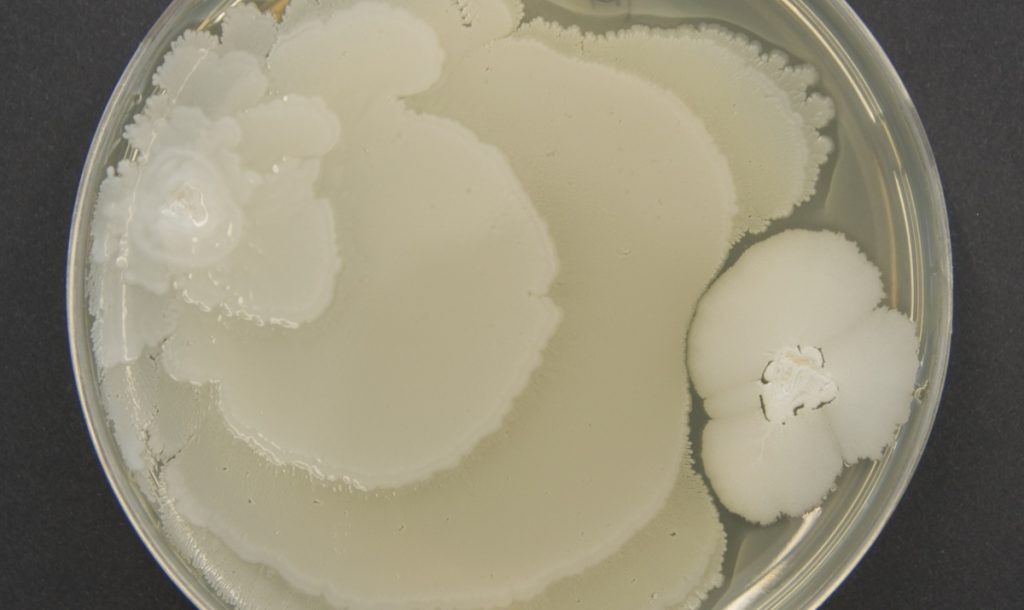
Bacillus causes the most common bacterial contamination in mushroom growing that growers call ‘sour rot’ or ‘wet spot.’
This contamination is commonly found at the bottom of grain jars and monotubs and gets its names from its sour smell and slimy gray appearance.
Dormant bacillus endospores are heat resistant and can survive sterilization, so to kill them, it’s best to soak your grain at room temperature for 12 to 24 hours before sterilization.
This encourages the endospores to germinate, and once germinated, they’re no longer heat resistant, and sterilization will kill them.
You may be able to separate bacillus contamination from the rest of the myceliated substrate if you find a small localized patch.
Cultivators recommend scooping out the slimy patch with a sterilized spoon.
8. Pseudomonas spp.

Pseudomonas bacteria are naturally present and usually harmless to mushroom fruiting bodies, but excessive water on the mushroom’s surface causes problems.
Excess water caused by overmisting, condensation or insufficient air exchange increases the amount of pseudomonas present.
And in large quantities, the enzymes they produce degrade the mushroom’s cell walls, causing brown spots.
In the early stages, these spots usually do not affect the taste or texture of the mushrooms. But when left in wet conditions, it can progress, creating larger, brown, slimy patches and degrading portions of the mushroom cap.
Providing adequate air exchange to prevent water droplets from staying on the mushrooms for extended periods is the best way to prevent this bacteria from damaging your crop.
Pest Contaminants
Many pests that damage mushroom crops are microscopic, and you won’t know you have a problem until it’s too late.
Preventative measures like pasteurization, sterilization, fly screens or air-tight growing spaces with filtered air all help to prevent pest contamination.
Below are three common mushroom-growing pest contaminants.
9. Mites
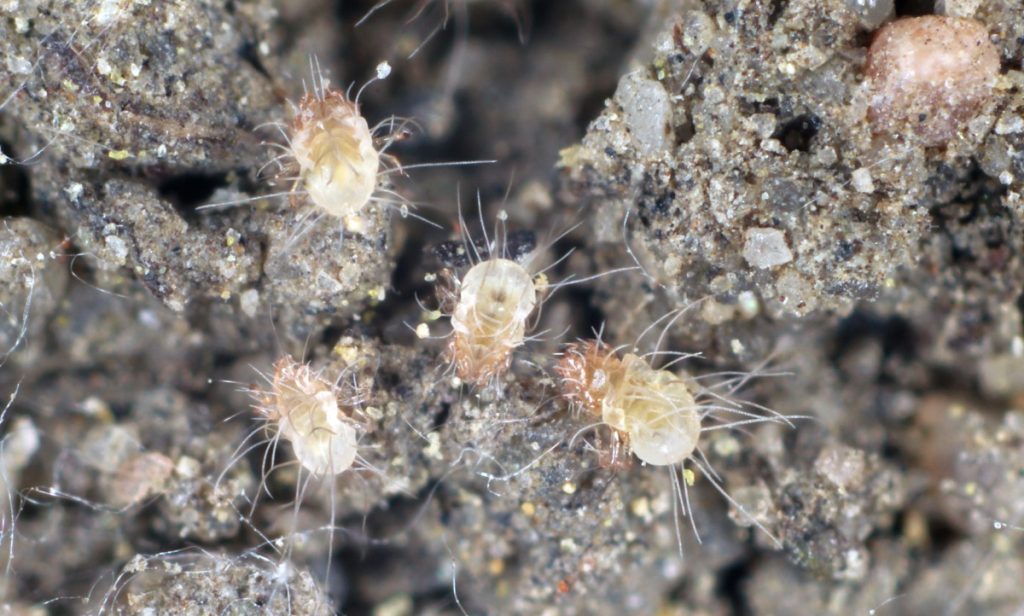
Mites are commonly found in substrate materials like straw or manure, and while some are beneficial to mushroom growing, others damage mushroom crops.
Microscopic Tarsonemid mites, for example, feed on mushroom hyphae and, in large enough numbers, can eat through a mushroom stem, detaching it from the substrate.
Although you cannot see these mites, you’ll know you have a problem if you notice a reddish-brown discoloration at the base of your mushroom stems.
Tyroglyphid mites also feed on mycelium and mushrooms, making small holes in their caps that become breeding grounds for bacterial contaminants.
And then there are red pepper mites that feed on molds, not mushrooms.
Although they won’t eat your mushrooms, lots of small yellowish-brown mites in your growing space usually mean there’s Trichoderma nearby, and they will spread it around the grow room.
It’s crucial to pasteurize your substrate correctly to kill any mites because once they get into your growing room, it’s challenging to get rid of them.
10. Insects
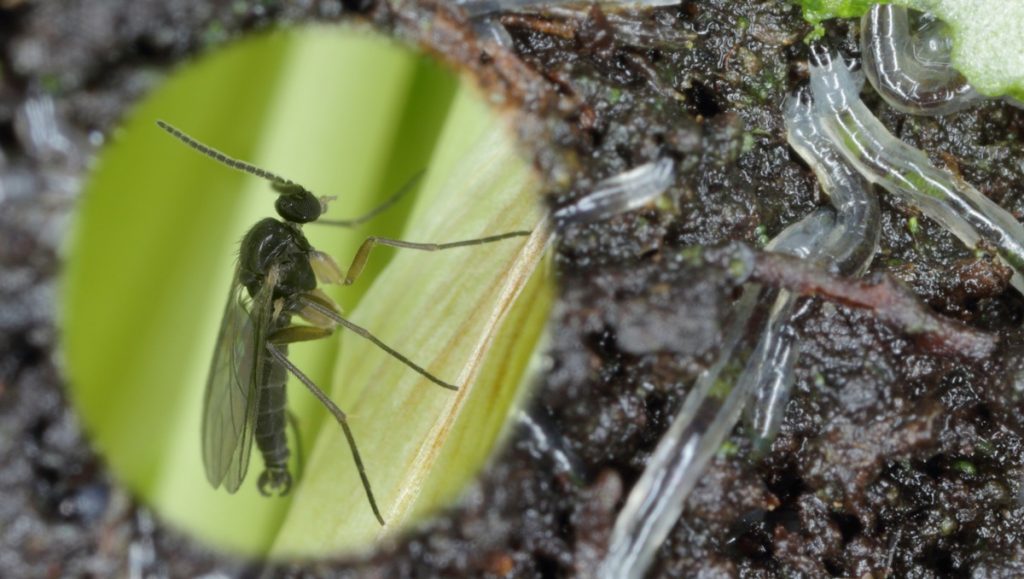
There are several flies and gnats whose larvae feed on mycelium and mushroom fruiting bodies.
And it is not only the larvae that cause damage. Adult flies are super active and transport bacterial and fungal contaminants from one fruiting block to another.
Below are two common pests you’ll want to keep out of your growing space:
- Sciarid flies or fungus gnats – These are the most common pest contaminants, and they damage mushroom crops at every stage of the process, from incubation to harvest. Their larvae feed on mushroom mycelium and tunnel into developing mushroom fruiting bodies, causing damage that often leads to soft rot.
- Cecid flies – The larvae of these flies are most dangerous as they multiply quickly and spread by clinging onto tools and equipment. They feed on mature mushrooms’ mycelium, stems and gills, causing significant crop losses.
11. Nematodes

Nematodes are microscopic organisms found in most soils and usually considered beneficial for soil health, but several nematodes feed on mushroom mycelium.
Nematodes are more common in manure or compost-based substrates, and the best way to prevent an infestation is to ensure correct pasteurization procedures.
The first sign of a nematode infestation is the degeneration of mushroom mycelium. Eventually, infected mycelium is destroyed, and no mushrooms form.
Common Causes of Contamination
Many mushroom-growing contaminants are microscopic and easily transported into the mushroom-growing environment in various ways.
Below are some of the common causes of contamination:
Airborne Contamination
The air around us is full of fungal spores, bacteria, viruses and other organisms that could contaminate your substrate, mushrooms or fruiting chamber.
Airborne contaminants are most dangerous during inoculation, as you often have to expose your sterilized substrate to air while inserting mushroom culture or spawn.
To minimize the amount of airborne contaminants reaching their substrates, mushroom cultivators recommend inoculating in a still air box or in front of a laminar flow hood.
Fruiting chambers and grow rooms can also become breeding grounds for unwanted organisms that damage mushroom crops.
This is usually due to poor ventilation, causing high carbon dioxide levels and excess humidity. Ideal growing conditions for harmful airborne organisms.
Substrate Contamination
The nutrient-rich organic materials that mushroom growers use as substrates are also breeding grounds for unwanted fungal spores and bacteria.
This means your substrate can also introduce contaminants to the growing process, which is why it’s always best to source high-quality substrates that are as clean as possible to begin with.
Then, depending on the type of substrate and mushroom species you’re growing, you’ll need to pasteurize or sterilize your substrate.
Pasteurization reduces the number of competing organisms but does not kill all of them. Sterilization eliminates all undesirable organisms, giving your mushroom mycelium the best possible head start.
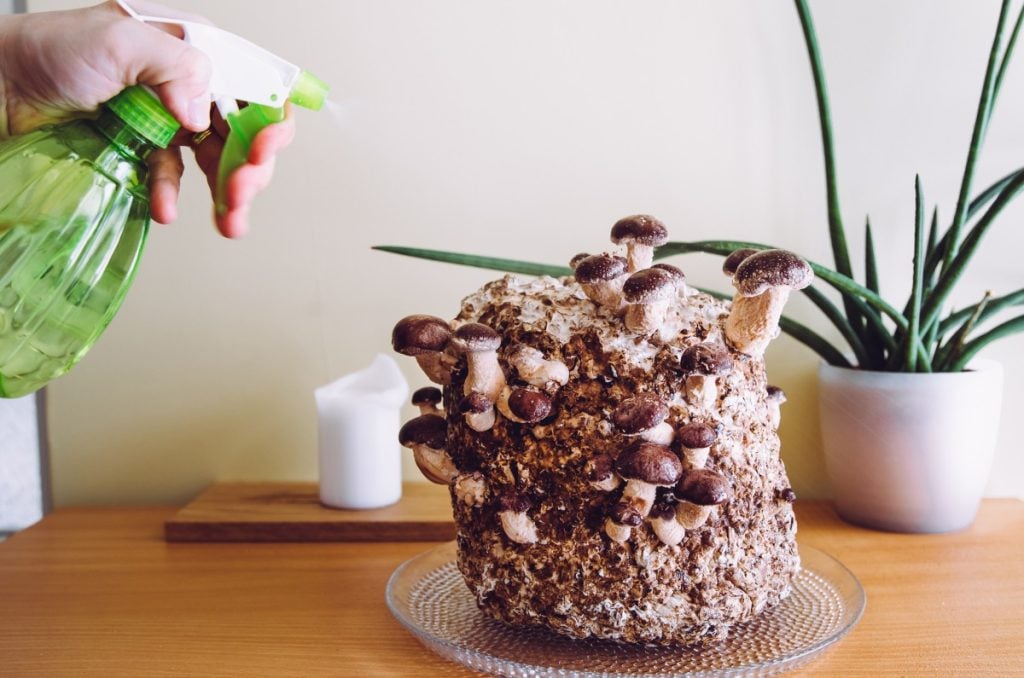
Waterborne Contamination
High humidity levels are required during the entire mushroom growing process. To maintain these levels, you need water.
Using polluted water in your humidifier or when misting your mushrooms can introduce mold, bacteria or viruses into your growing environment.
Although waterborne contamination is not as common as airborne or equipment contamination, you can help prevent waterborne contamination in fruiting chambers by using sterilized water.
Equipment Contamination
Equipment and tools that are not thoroughly cleaned can introduce harmful microorganisms into your substrate or growing environment.
This is especially relevant during the inoculation process when working with sterilized substrates.
It’s crucial to wipe down your work surface and any tools with alcohol and flame sterilize scalpels and needles to help prevent equipment from introducing contaminants during inoculation,
You’ll also need to clean any equipment you intend to use inside your fruiting chamber, such as thermometers or hygrometers, with a cloth and some alcohol.
Additionally, if you’re using a humidifier to maintain humidity levels, you should inspect and clean it regularly to ensure it doesn’t become a breeding ground for harmful organisms.
Human Contact Contamination
Human contact is one of the most common sources of contamination when growing mushrooms. Microorganisms are not only in the air around us. They’re also in our hair and on our hands and clothing.
Before you work in your mushroom-growing environment, it’s advisable to take a shower, use hand sanitizer, and put on clean clothes or a lab coat.
Wearing gloves, masks and hair nets also helps reduce the chances of introducing contaminants into the mushroom-growing environment.
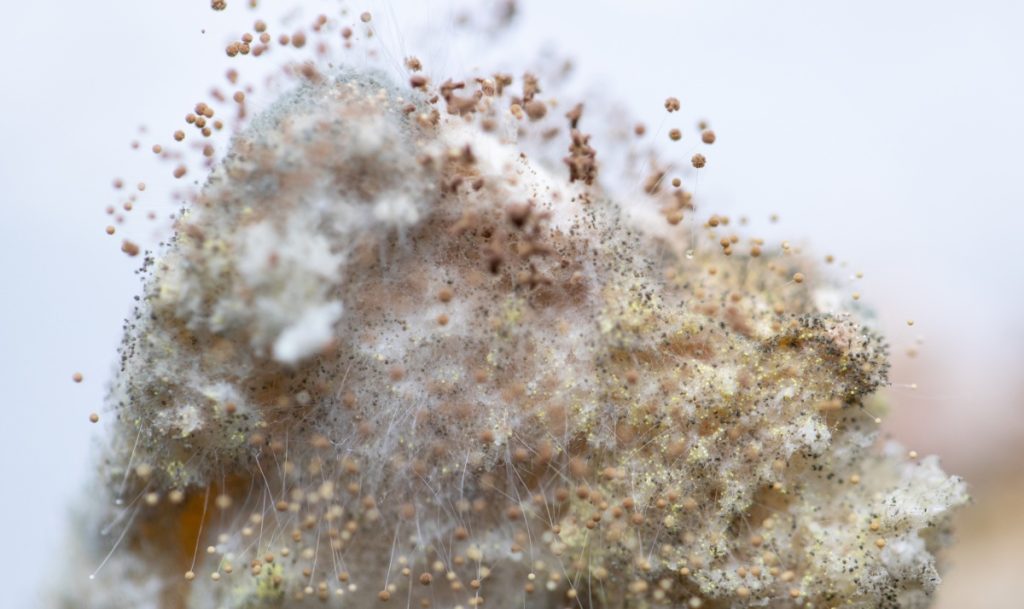
Early Warning Signs of Contamination
Contamination can be very hard to spot, especially in the early stages, but there are a few signs to keep an eye out for, including:
- Visual signs of mold
- Uncolonised patches of spawn or substrate
- Strong odors that may be sour for bacterial or musty for fungal contamination
- Abnormal growth
- Slimy patches
- Yellow or brown spots or streaks
Impact of Contamination on Mushroom Yield
The impact of contamination on mushroom yields is significant. It can inhibit growth, cause deformities or cause an entire crop to fail.
Contaminants that compete with the mushroom mycelium during the incubation phase may outcompete the mycelium altogether, resulting in failed colonization and no mushrooms.
Contamination after pinning can cause deformed fruiting bodies, smaller yields or discolored mushrooms unsuitable for the market.
Will Contaminated Mycelium Fruit?
Contaminated mycelium may fruit if the contamination occurs when colonization is almost complete, meaning the mycelium has consumed most of the nutrients in the substrate.
As many contaminants feed not only on the substrate but also on the mycelium itself, you’ll also need to catch any contaminants in the early stages before they weaken the mycelium.
You may be able to isolate and remove small spots of bacterial contamination before they spread, leaving the remaining mycelium to fruit.
And spraying some early-stage molds with a hydrogen peroxide solution will destroy them, allowing the mycelium to fruit. But you may have smaller yields.
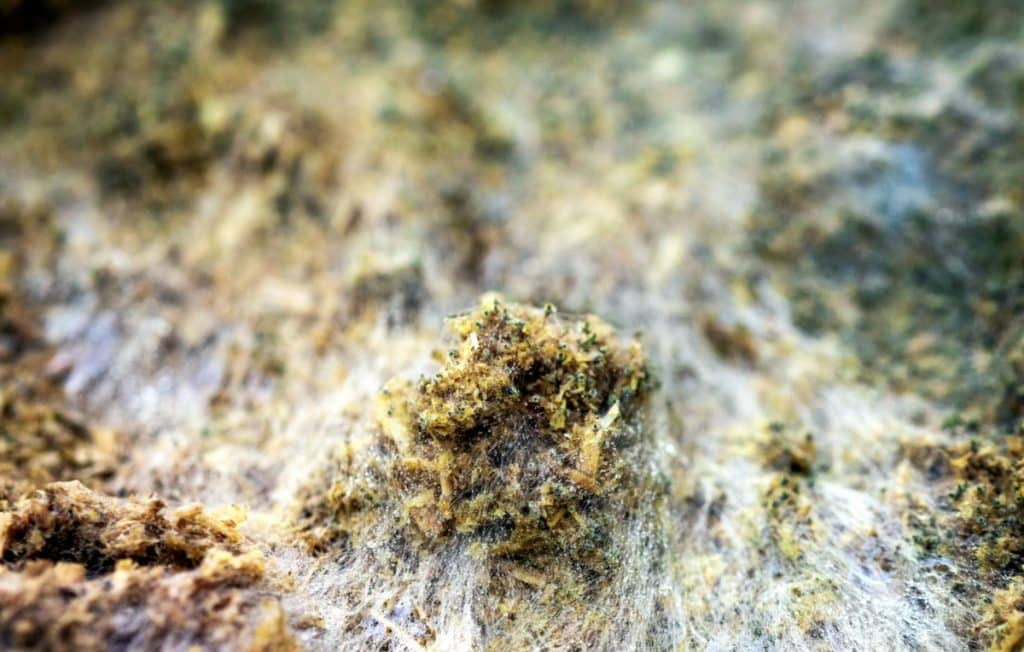
Tips for Preventing Contamination
Growing mushrooms is a skill, and like all skills, it takes practice and trial and error to learn what works best for you.
Contamination is one of the most common obstacles encountered by beginner mushroom growers. So, how can we prevent contamination in mushroom cultivation?
The answer is to reduce or eliminate exposure to contaminated air, equipment and people.
Here are some tips to help prevent contamination:
- Only use substrate materials that have been kept dry and clean
- Correctly sterilize substrate before inoculation
- Inoculate in front of a flow hood with HEPA air filters
- Create positive pressure HEPA-filtered air inside a mushroom lab or clean room for inoculation
- Wear a face mask, surgical gloves, and a Tyvek suit during inoculation
- Isolate any infected mushrooms immediately to prevent the contamination from spreading
- Remove any contaminated substrate from grow rooms immediately
- Seal grow rooms with fly screens to block access for flies
- Hang fly strips in your fruiting room to catch and monitor insect populations
- Wash hands well before harvesting
Final Thoughts
Although the list of potential contaminants may seem daunting, especially to beginners, it’s not as bad as it may seem.
Many delicious gourmet mushroom species, like oyster mushrooms and shiitake mushrooms, have adapted mechanisms to deal with competitors.
Their mycelium is fast growing and, once established, secretes an enzyme that can kill small quantities of mold, making it difficult for mold to grow.
We suggest beginner mushroom growers start with oyster mushrooms as they’re hardy and fast-growing, reducing the chances of contamination and making it easier to experience the wonder of harvesting your first flush of mushrooms.
To learn more about growing mushrooms the low-tech way, visit our Mushroom Growing Hub or try one of our mushroom cultivation courses.
